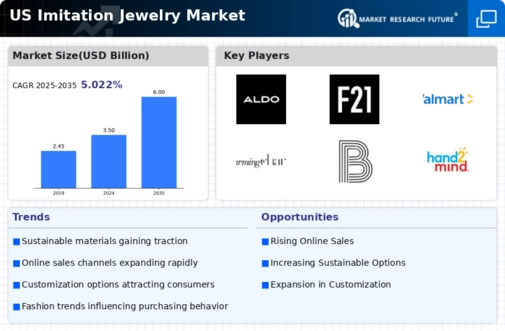The imitation jewelry market exhibits a dynamic competitive landscape characterized by a blend of innovation, strategic partnerships, and regional expansion. Key players such as Zales (US), Jared (US), and Kendra Scott (US) are actively shaping the market through their distinct operational focuses. Zales (US) emphasizes a robust digital transformation strategy, enhancing its online presence to cater to a tech-savvy consumer base. Meanwhile, Jared (US) has been focusing on expanding its product lines to include more sustainable materials, reflecting a growing consumer preference for eco-friendly options. Kendra Scott (US) stands out with its community-centric approach, leveraging local partnerships to enhance brand loyalty and customer engagement. Collectively, these strategies contribute to a moderately fragmented market, where innovation and customer experience are pivotal in driving competitive advantage.
In terms of business tactics, companies are increasingly localizing manufacturing to reduce lead times and optimize supply chains. This approach not only enhances responsiveness to market demands but also aligns with sustainability goals by minimizing transportation emissions. The competitive structure remains moderately fragmented, with numerous players vying for market share, yet the influence of major brands is palpable as they set trends and consumer expectations.
In October 2025, Zales (US) launched a new line of customizable imitation jewelry, allowing customers to personalize their pieces through an online platform. This strategic move is significant as it taps into the growing trend of personalization in consumer goods, potentially increasing customer engagement and driving sales. By offering customization, Zales (US) positions itself as a leader in innovation within the market, appealing to consumers seeking unique and tailored products.
In September 2025, Jared (US) announced a partnership with a sustainable materials supplier to incorporate recycled materials into its imitation jewelry collections. This initiative not only aligns with the increasing consumer demand for sustainability but also enhances Jared's brand image as a responsible retailer. The strategic importance of this partnership lies in its potential to attract environmentally conscious consumers, thereby expanding Jared's market reach and reinforcing its commitment to sustainability.
In August 2025, Kendra Scott (US) expanded its community outreach programs, launching initiatives that support local artisans and promote craftsmanship in imitation jewelry. This strategic action underscores Kendra Scott's commitment to social responsibility and community engagement, which are increasingly valued by consumers. By fostering local talent, Kendra Scott (US) not only enhances its brand reputation but also differentiates itself in a crowded market.
As of November 2025, the imitation jewelry market is witnessing trends such as digitalization, sustainability, and the integration of AI technologies. These trends are reshaping competitive dynamics, with companies increasingly forming strategic alliances to enhance their market positions. The shift from price-based competition to a focus on innovation, technology, and supply chain reliability is evident. Moving forward, differentiation will likely hinge on the ability to leverage technology and sustainability, as consumers increasingly prioritize these attributes in their purchasing decisions.
























Leave a Comment